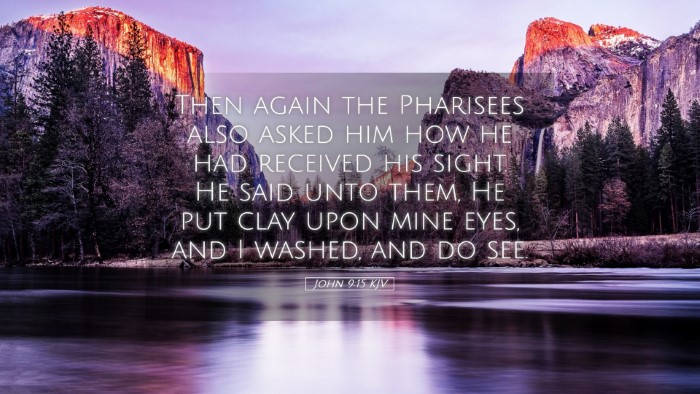Commentary on John 9:15
Bible Verse: "Then the Pharisees also asked him how he had received his sight. He said unto them, He put clay upon mine eyes, and I washed, and do see."
Introduction
John 9:15 presents a pivotal moment in the narrative of Jesus healing a man born blind. This verse embodies the tensions between divine authority and religious scrutiny, illustrating the dynamics of faith, revelation, and the reaction of those who are confronted with miracles. The insights from public domain commentaries provide depth and context to understanding this scripture.
Contextual Background
The Gospel of John is distinct in its emphasis on the miraculous signs of Jesus as manifestations of His divine nature. In John 9, the narrative focuses on the healing of the blind man, offering a powerful metaphor for spiritual blindness versus sight. The response of the Pharisees to this miraculous healing reveals their profound misunderstanding and hardheartedness.
Interpretative Insights
-
Matthew Henry’s Commentary
Matthew Henry emphasizes the contrast between the man who was healed and the Pharisees. He notes that the healed man's simplicity and straightforwardness in his narrative stands in stark contrast to the complicated reasoning of the religious leaders. According to Henry, the man's proclamation of his healing serves as both a testimony to the power of Jesus and a challenge to the complacency of the Pharisees.
-
Albert Barnes’ Notes
Barnes highlights the incredulity of the Pharisees, illustrating their obsession with their own traditions and their inability to acknowledge the work of God in Jesus. He suggests that their questioning represents a broader theme in John's Gospel where religious leaders often fail to recognize the truth revealed by Jesus. Barnes also points out the significance of the clay used in the healing, symbolizing the creative act of God and how it often challenges human expectations and interpretations of divine work.
-
Adam Clarke’s Commentary
Adam Clarke elaborates on the significance of the healed man's response. Clarke notes that the man's statement, “I washed, and do see,” encapsulates the essence of faith and obedience to Christ's command. Furthermore, he argues that the act of washing signifies an important aspect of spiritual cleansing and restoration. Clarke emphasizes the importance of the blind man's testimony, pointing out that it asserts not only the miraculous nature of his healing but also the authority of Jesus as the Messiah.
Theological Implications
This verse serves as an embodiment of several theological themes:
- The Nature of Spiritual Blindness: The passage illustrates how profound spiritual insight can be profoundly resisted by those who are entrenched in religious tradition.
- The Role of Testimony: The healed man's testimony sheds light on the importance of personal experience in the life of faith. His simple declaration becomes a witness to Jesus' transformative power.
- The Sovereignty of Jesus: The act of Jesus healing highlights His divine authority and ability to restore not just physical sight but also a deeper spiritual sight.
Reflections for Pastors and Theologians
For pastors and theologians, John 9:15 offers rich material for reflection on the nature of faith, the dynamics of belief in the face of religious opposition, and the role of personal testimony in witnessing to the truth of Jesus. The clear contrast between the man's faith and the skepticism of the Pharisees provides a poignant reminder of the dangers of being so entrenched in tradition that one misses the work of God happening in their midst.
Application for Contemporary Faith Communities
Faith communities today can draw several lessons from this encounter:
- Encouraging Genuine Testimony: Just as the healed man gave witness to his change, modern believers are encouraged to share their experiences of God's work in their lives.
- Recognizing Spiritual Blindness: Communities must remain vigilant against spiritual blindness, being open to how God may work outside of established norms and traditions.
- Valuing Simplicity in Faith: The simplicity of the healed man's response should encourage believers that faith, at its core, is straightforward and personal.
Conclusion
John 9:15 encapsulates a significant moment of revelation, illustrating the power of Jesus to transform lives and the resistance that such divine acts can provoke among those who are spiritually blind. The insights drawn from Matthew Henry, Albert Barnes, and Adam Clarke illuminate the challenges faced by believers and the richness of personal testimony in the journey of faith. This scriptural passage serves as a call to recognize and respond to the work of Christ in our lives today.


